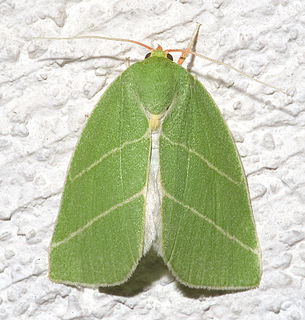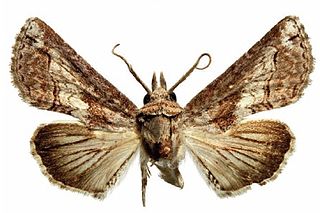
Chloephorinae is a subfamily of the moth family Nolidae. It includes, among others, many of the moths known as silver-lines. They are rather similar to some owlet moths (Noctuidae) in appearance and often colored a vivid green, but may also be brown, grey, or white.

Hypena is a genus of moths in the family Erebidae. It was first described by Franz von Paula Schrank in 1802. These non-migratory moths overwinter as pupae and almost never come to bait as adults.

Omiodes is a moth genus in the family Crambidae. Several species are endemic to Hawaii.
Garudinia is a genus of moths in the subfamily Arctiinae first described by Moore in 1882.
Lambula is a genus of moths in the family Erebidae. The genus was erected by Francis Walker in 1866.

Gabara is a genus of moths in the family Erebidae. The genus was erected by Francis Walker in 1866.

Euteliidae is a family of moths in the superfamily Noctuoidea. The family was erected by Augustus Radcliffe Grote in 1882.

The Chrysauginae are a subfamily of snout moths. They are primarily Neotropical and include about 400 described species.
Garudinia conjuncta is a moth of the family Erebidae. It was described by Jagbir Singh Kirti and Navneet Singh Gill in 2009. It is found in Karnataka, India.
Garudinia pseudosimulana is a moth of the family Erebidae. It was described by Jagbir Singh Kirti and Navneet Singh Gill in 2008. It is found in Karnataka, India.
Garudinia acornuta is a moth of the family Erebidae first described by Jeremy Daniel Holloway in 1982. It is found on Peninsular Malaysia, Borneo and Java. The habitat consists of dipterocarp forests, lower montane forests and lowland forests.

Garudinia bimaculata is a moth of the family Erebidae first described by Walter Rothschild in 1912. It is found on Borneo and Sulawesi and in Taiwan.
Garudinia biplagiata is a moth of the family Erebidae first described by George Hampson in 1896. It is found in Bhutan.
Garudinia latana is a moth of the family Erebidae first described by Francis Walker in 1863. It is found in Sri Lanka.
Garudinia macrolatana is a moth of the family Erebidae first described by Jeremy Daniel Holloway in 2001. It is found on Borneo. The habitat consists of lowland forests.
Garudinia pseudolatana is a moth of the family Erebidae first described by Jeremy Daniel Holloway in 2001. It is found on Borneo. The habitat consists of lowland forests.

Garudinia simulana is a moth of the family Erebidae first described by Francis Walker in 1863. It is found on Borneo. The habitat consists of lower montane forests.
Garudinia triangulata is a moth of the family Erebidae first described by Jeremy Daniel Holloway in 2001. It is found on Borneo. The habitat consists of lowland dipterocarp forests and from lower montane forests.

The Cisthenina are a subtribe of lichen moths in the family Erebidae, currently containing 428 described species.








